state的源代码中对createStore进行了解释。
In this article, we will understand how createStore in Zustand’s source code is written/works.
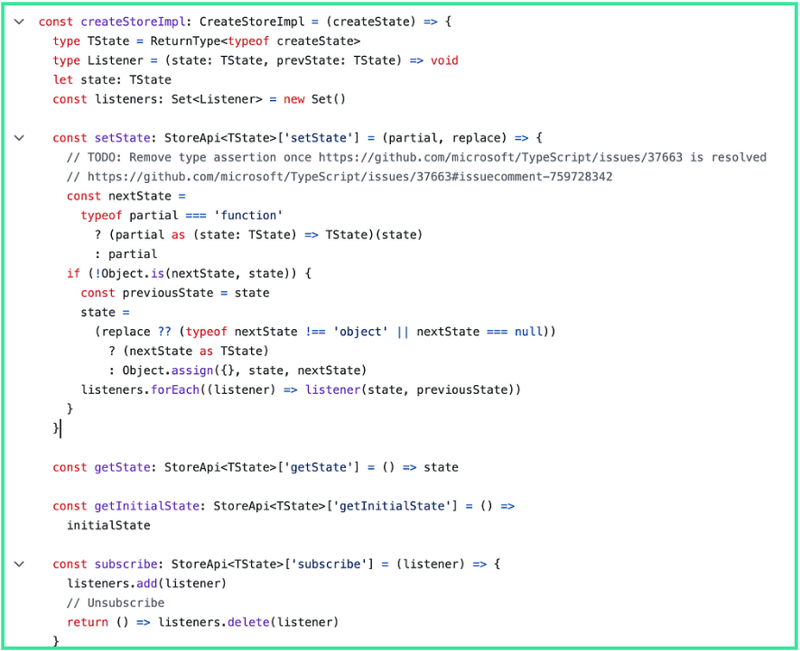
createStore is exported from vanilla.ts and you will find this at the end of the file.
export const createStore = ((createState) => createState ? createStoreImpl(createState) : createStoreImpl) as CreateStore
createStore is arrow function that accepts a parameter called createState. if createState exists, createStoreImpl(createState) is called.
createStoreImpl
const createStoreImpl: CreateStoreImpl = (createState) => {
type TState = ReturnType<typeof createState>
type Listener = (state: TState, prevState: TState) => void
let state: TState
const listeners: Set<Listener> = new Set()
const setState: StoreApi<TState>['setState'] = (partial, replace) => {
// TODO: Remove type assertion once https://github.com/microsoft/TypeScript/issues/37663 is resolved
// https://github.com/microsoft/TypeScript/issues/37663#issuecomment-759728342
const nextState =
typeof partial === 'function'
? (partial as (state: TState) => TState)(state)
: partial
if (!Object.is(nextState, state)) {
const previousState = state
state =
(replace ?? (typeof nextState !== 'object' || nextState === null))
? (nextState as TState)
: Object.assign({}, state, nextState)
listeners.forEach((listener) => listener(state, previousState))
}
}
const getState: StoreApi<TState>['getState'] = () => state
const getInitialState: StoreApi<TState>['getInitialState'] = () =>
initialState
const subscribe: StoreApi<TState>['subscribe'] = (listener) => {
listeners.add(listener)
// Unsubscribe
return () => listeners.delete(listener)
}
const api = { setState, getState, getInitialState, subscribe }
const initialState = (state = createState(setState, getState, api))
return api as any
}
In our previous articles, I have written about how setState, subscribe work. We will cover the remaining functions such as getState, getInitialState, createState.
getState
getState simply returns the state that is declared at the top of this createStoreImpl function.
const getState: StoreApi<TState>['getState'] = () => state
getInitialState
getInitialState returns the initialState.
const getInitialState: StoreApi<TState>['getInitialState'] = () =>
initialState
createState
createState is used to initialise the state variable.
const createStoreImpl: CreateStoreImpl = (createState) => {
createState is a parameter in createStoreImpl. Let’s run some experiments using the demo example provided in the Zustand’s repo.
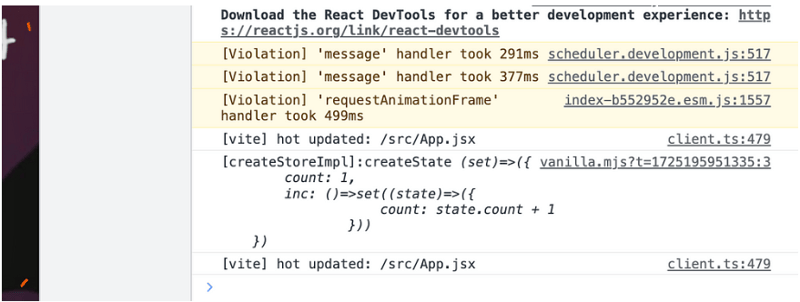
This is basically just what you pass into “create”
// Create the store using Zustand
const useStore = create((set) => ({
count: 1,
inc: () => set((state) => ({ count: state.count + 1 })),
}));
State initialisation happens in vanilla.ts at L93, even though create is originally exported from React, react.ts internally calls createStore in vanilla.ts.
So how does calling createState initializes the state?
const initialState = (state = createState(setState, getState, api))
The trick lies in calling the arrow function, createState. From the above code snippet, you can see that createState is called with setState, getState, api
Let’s run some experiments with this information. Let’s pass a custom function named test as the parameter without the original parameters.
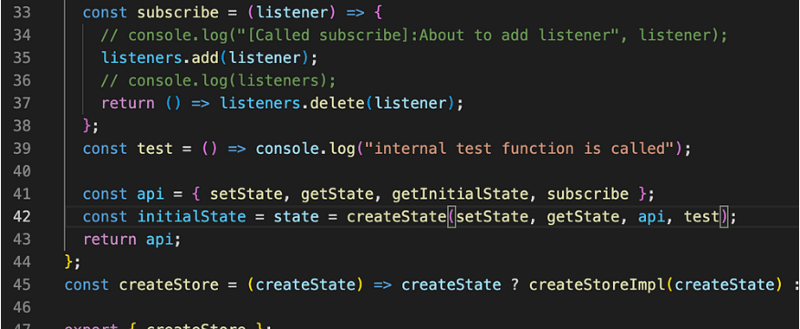
The above image shows the custom test function I added to demonstrate how the parameters are passed to createState function.
let’s now see this internal test function in action. For us to access this test function, the following example shows how createStore can be initialised with this newly added test parameter.
// Create the store using Zustand
const useStore = create((set, get, api, test) => ({
count: 1,
inc: () => set((state) => ({ count: state.count + 1 })),
test: () => test()
}));
Because we exposed test in vanilla.mjs as shown below, you will have access to this function when you initialise the create function
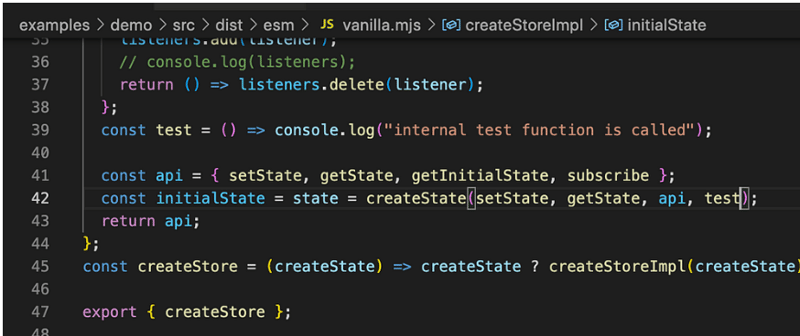
I am triggering this test function when the button in the demo example is clicked.
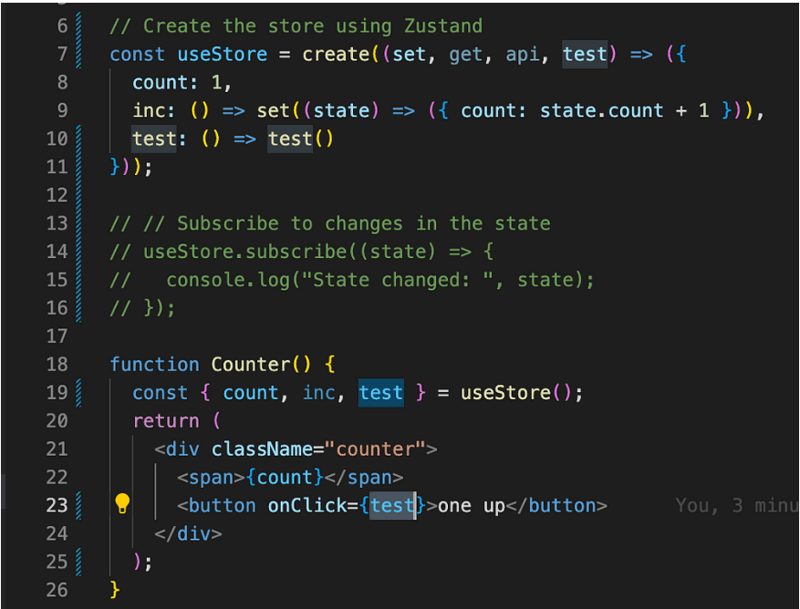
This, in turn, calls the test function.
This is some advanced JavaScript arrow functions usage and oh, we also just added a custom test function and used in the demo app. That is cool.
About us:
At Think Throo, we are on a mission to teach the best practices inspired by open-source projects.
10x your coding skills by practising advanced architectural concepts in Next.js/React, learn the best practices and build production-grade projects.
We are open source — https://github.com/thinkthroo/thinkthroo (Do give us a star!)
Looking to build bespoke web systems for your business? Contact us at hello@thinkthroo.com
About the author:
Hey, I’m Ram. I am a passionate software engineer/OSS Tinkerer.
Checkout my website: https://www.ramunarasinga.com/
References:
- https://github.com/pmndrs/zustand/blob/main/src/vanilla.ts#L97
以上是state的源代码中对createStore进行了解释。的详细内容。更多信息请关注PHP中文网其他相关文章!

热AI工具

Undresser.AI Undress
人工智能驱动的应用程序,用于创建逼真的裸体照片

AI Clothes Remover
用于从照片中去除衣服的在线人工智能工具。

Undress AI Tool
免费脱衣服图片

Clothoff.io
AI脱衣机

Video Face Swap
使用我们完全免费的人工智能换脸工具轻松在任何视频中换脸!

热门文章

热工具

记事本++7.3.1
好用且免费的代码编辑器

SublimeText3汉化版
中文版,非常好用

禅工作室 13.0.1
功能强大的PHP集成开发环境

Dreamweaver CS6
视觉化网页开发工具

SublimeText3 Mac版
神级代码编辑软件(SublimeText3)
 神秘的JavaScript:它的作用以及为什么重要
Apr 09, 2025 am 12:07 AM
神秘的JavaScript:它的作用以及为什么重要
Apr 09, 2025 am 12:07 AM
JavaScript是现代Web开发的基石,它的主要功能包括事件驱动编程、动态内容生成和异步编程。1)事件驱动编程允许网页根据用户操作动态变化。2)动态内容生成使得页面内容可以根据条件调整。3)异步编程确保用户界面不被阻塞。JavaScript广泛应用于网页交互、单页面应用和服务器端开发,极大地提升了用户体验和跨平台开发的灵活性。
 JavaScript的演变:当前的趋势和未来前景
Apr 10, 2025 am 09:33 AM
JavaScript的演变:当前的趋势和未来前景
Apr 10, 2025 am 09:33 AM
JavaScript的最新趋势包括TypeScript的崛起、现代框架和库的流行以及WebAssembly的应用。未来前景涵盖更强大的类型系统、服务器端JavaScript的发展、人工智能和机器学习的扩展以及物联网和边缘计算的潜力。
 JavaScript引擎:比较实施
Apr 13, 2025 am 12:05 AM
JavaScript引擎:比较实施
Apr 13, 2025 am 12:05 AM
不同JavaScript引擎在解析和执行JavaScript代码时,效果会有所不同,因为每个引擎的实现原理和优化策略各有差异。1.词法分析:将源码转换为词法单元。2.语法分析:生成抽象语法树。3.优化和编译:通过JIT编译器生成机器码。4.执行:运行机器码。V8引擎通过即时编译和隐藏类优化,SpiderMonkey使用类型推断系统,导致在相同代码上的性能表现不同。
 Python vs. JavaScript:学习曲线和易用性
Apr 16, 2025 am 12:12 AM
Python vs. JavaScript:学习曲线和易用性
Apr 16, 2025 am 12:12 AM
Python更适合初学者,学习曲线平缓,语法简洁;JavaScript适合前端开发,学习曲线较陡,语法灵活。1.Python语法直观,适用于数据科学和后端开发。2.JavaScript灵活,广泛用于前端和服务器端编程。
 JavaScript:探索网络语言的多功能性
Apr 11, 2025 am 12:01 AM
JavaScript:探索网络语言的多功能性
Apr 11, 2025 am 12:01 AM
JavaScript是现代Web开发的核心语言,因其多样性和灵活性而广泛应用。1)前端开发:通过DOM操作和现代框架(如React、Vue.js、Angular)构建动态网页和单页面应用。2)服务器端开发:Node.js利用非阻塞I/O模型处理高并发和实时应用。3)移动和桌面应用开发:通过ReactNative和Electron实现跨平台开发,提高开发效率。
 如何使用Next.js(前端集成)构建多租户SaaS应用程序
Apr 11, 2025 am 08:22 AM
如何使用Next.js(前端集成)构建多租户SaaS应用程序
Apr 11, 2025 am 08:22 AM
本文展示了与许可证确保的后端的前端集成,并使用Next.js构建功能性Edtech SaaS应用程序。 前端获取用户权限以控制UI的可见性并确保API要求遵守角色库
 使用Next.js(后端集成)构建多租户SaaS应用程序
Apr 11, 2025 am 08:23 AM
使用Next.js(后端集成)构建多租户SaaS应用程序
Apr 11, 2025 am 08:23 AM
我使用您的日常技术工具构建了功能性的多租户SaaS应用程序(一个Edtech应用程序),您可以做同样的事情。 首先,什么是多租户SaaS应用程序? 多租户SaaS应用程序可让您从唱歌中为多个客户提供服务
 从C/C到JavaScript:所有工作方式
Apr 14, 2025 am 12:05 AM
从C/C到JavaScript:所有工作方式
Apr 14, 2025 am 12:05 AM
从C/C 转向JavaScript需要适应动态类型、垃圾回收和异步编程等特点。1)C/C 是静态类型语言,需手动管理内存,而JavaScript是动态类型,垃圾回收自动处理。2)C/C 需编译成机器码,JavaScript则为解释型语言。3)JavaScript引入闭包、原型链和Promise等概念,增强了灵活性和异步编程能力。






